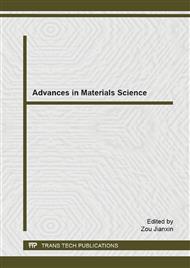[1]
H. Bataller, S. Lamaallam, J. Lachaise, A. Graciaa, C. Dicharry, Cutting fluid emulsions produced by dilution of a cutting fluid concentrate containing a cationic/nonionic surfactant mixture, J. Mater. Process. Technol. 152 (2004) 215–220.
DOI: 10.1016/j.jmatprotec.2004.03.027
Google Scholar
[2]
M. Sokovic, K. Mijanovic, Ecological aspects of cutting fluids and to their quantifiable influence one parameters of the cutting processes, J. Mater. Process. Technol. 109 (2001) 181–189.
DOI: 10.1016/s0924-0136(00)00794-9
Google Scholar
[3]
Hongjun Liu. The MBR of three kinds of anionic surfactant wastewater treatment research [D]. Master degree theses of Master of Harbin Engineering university, (2007).
Google Scholar
[4]
Shuanxi Fan. High concentration of oil emulsified liquid waste processing research [D]. Master degree theses of Master of Xian Building University of Science and Technology, (2008).
Google Scholar
[5]
Hilal N,Busca G, Hankins N, et a1.The use of ultrafiltration and nanofiltration membranes in the treatment of metal-working fluids[J].Desalination,2004,167: 227-238.
DOI: 10.1016/j.desal.2004.06.132
Google Scholar
[6]
Chen AS C,Flynn J T,Cook R G et a1.Removal of oil,greasa and suspended solids from produced water with ceramic cross flow microfiltration[J].Society of Petroleum Engineers, 1991,6(2): 131-136.
DOI: 10.2118/20291-pa
Google Scholar
[7]
N Hilal, G Busca, N Hankins, AW Mohammad. The use of ultrafiltration and nan-ofiltration membranes in the treatment of metal-working fluids. [J]. Desalination 2004; 167: 227-238.
DOI: 10.1016/j.desal.2004.06.132
Google Scholar
[8]
Kaimian Yang. Demulsification-Fenton-reagent method research on oil emulsified liquid waste processing [D]. Master degree theses of the Master of Xian Building University of Science and Technology, (2010).
Google Scholar
[9]
Urdahl 0,Williams T J,Bailey A G,et a1.Electrostatic destabilization of water-in-oil emulsions under conditions of turbulent flow[J].Chemical Engineering Research and Design,1996,74(2): l58~165.
Google Scholar
[10]
Lang Wang, Shaoqi Shi, Zhanpeng Jiang, etc. Demulsification + Fenton reagent method treatment of high concentration waste emulsion research [J]. Journal of Industrial Water Treatment, 2003, 23 (9) : 58-60.
Google Scholar
[11]
Tony M A,Purcell P J,Zhao YQ,et a1.Photo—catalytic degradation of an oil-water emulsion using the photo-fenton treatment process: effects and statistical optimization[J].Journal of Environmental Science and Health,2009, 44(2) : 179-181.
DOI: 10.1080/10934520802539830
Google Scholar
[12]
Xin Feng. The research progress of water-based cutting fluid waste liquid treatment [J]. Journal of Leading Chemical Industry, 2011, 40 (60): 596 ~ 598.
Google Scholar
[13]
Xuehang Cheng, Yilu Wang, Zhenjia Zhang. Coagulation air floatation anaerobic aerobic treatment process of cold rolling emulsified oil containing wastewater [J]. Industrial Water Treatment, 2010, 30 (4): 71-74.
Google Scholar


